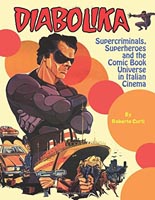 Author and film historian Roberto Curti is such an expert on Italian genre cinema, he literally wrote the books on them: 2013’s Italian Crime Filmography and 2015’s Italian Gothic Horror Films, both published by McFarland & Company. And he’s still writing them! In fact, Curti has two new books out this summer: Tonino Valerii: The Films for McFarland and, through Midnight Marquee, Diabolika: Supercriminals, Superheroes and the Comic Book Universe in Italian Cinema. It is the latter title — lavishly illustrated in full color with film stills, lobby cards, poster art and, yep, comic book panels — that inspires and informs his Guest List for Flick Attack.
Author and film historian Roberto Curti is such an expert on Italian genre cinema, he literally wrote the books on them: 2013’s Italian Crime Filmography and 2015’s Italian Gothic Horror Films, both published by McFarland & Company. And he’s still writing them! In fact, Curti has two new books out this summer: Tonino Valerii: The Films for McFarland and, through Midnight Marquee, Diabolika: Supercriminals, Superheroes and the Comic Book Universe in Italian Cinema. It is the latter title — lavishly illustrated in full color with film stills, lobby cards, poster art and, yep, comic book panels — that inspires and informs his Guest List for Flick Attack.
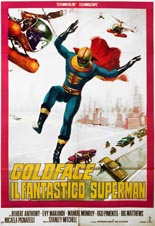 1. Goldface (Goldface il fantastico Superman, 1967)
1. Goldface (Goldface il fantastico Superman, 1967)
Born in the wake of the success of the El Santo series and conceived for the South American market, the eponymous protagonist of Bitto Albertini’s flick is not the kind of superhero one would often see, especially in this era of big-budget Hollywood adaptations. In the glorious tradition of Mexican luchadores films, Goldface is a meek scientist who moonlights as a popular and invincible masked wrestler. He has no superpowers, and his outfit (pale blue leotard, red cape and golden mask) is rather ugly-looking. He has a peanut-munching black sidekick named Kotar (!) who speaks exactly like the “poor negroes” in 1930s films, and together they ride a motorbike like a cut-rate version of Captain America and Falcon.
Still, despite its obvious shortcomings, there’s fun to be had watching Goldface il fantastico superman, mostly because the titular Goldface, played by Espartaco Santoni, is regularly replaced in the action scenes by ace stuntman Attilio Severini, who performs some incredible (and very dangerous) stunts, with no special effects whatsoever. Albertini recalled filming a scene where Severini falls into the Venezuelan sea from a helicopter from no less than 100 feet high, in barracuda-infested waters … a detail neither the stuntman nor the director had been informed of prior to shooting. Nothing could stop Severini. When he got the news that filming for Anthony Mann’s The Fall of the Roman Empire was about to begin in Cinecittà, Severini ran to the production office in a hurry. “I’m doing that one, I’m doing The Fall of the Roman Empire!” he claimed. “By the way, how high is that fall going to be?”
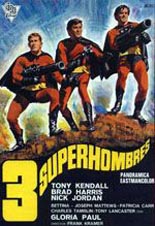 2. The Three Supermen (The Fantastic Three Supermen, 1967; 3 Supermen in Tokyo, 1968; Three Supermen in the Jungle, 1970; Supermen Against the Orient, 1973; The 3 Supermen in the West, 1973; 3 Supermen Against the Godfather, 1980; Three Supermen at the Olympic Games, 1984; Three Supermen in S. Domingo, 1986)
2. The Three Supermen (The Fantastic Three Supermen, 1967; 3 Supermen in Tokyo, 1968; Three Supermen in the Jungle, 1970; Supermen Against the Orient, 1973; The 3 Supermen in the West, 1973; 3 Supermen Against the Godfather, 1980; Three Supermen at the Olympic Games, 1984; Three Supermen in S. Domingo, 1986)
The longest superhero film series in Italy, spreading over three decades with eight official entries plus a number of rip-offs, was created by Gianfranco Parolini, who later moved on to the Western with the Sabata series starring Lee Van Cleef. Parolini took the concept from his sword-and-sandal flick 3 Avengers and developed it within a spy-cum-science-fiction context.
Conceived as amiable comedies for audiences of all ages, the Three Supermen films are about a trio of unlikely heroes in bulletproof red leotard and cape, and the plots usually feature an FBI agent recruiting two acrobat thieves (one of them mute) to perform some dangerous mission, involving duplicating or shrinking devices, or even time machines. The gags mostly rely upon never-ending fistfights à la Bud Spencer and Terence Hill, and the leads are expert stuntmen such as Aldo Canti (aka Nick Jordan) or Sal Borgese; the latter (playing the mute of the trio) usually has a scene in drag in each film. Another invariable moment has the Three Supermen madly laughing and making faces in their bulletproof costumes as their adversaries vainly attempt to dispatch them via machine guns and the like.
The Three Supermen’s adventures around the world reflected the nomadic quality of Italian popular cinema and its capability of vampirizing whatever was “hot” from time to time, before jumping onto the next filone, from the exotic jungle adventure to the gongfupian, from the Trinità-style spaghetti Western to the short-lived Amazons fever briefly sparked (at least in Italy) by Terence Young’s film War Goddess (1973), for the Shaw Brothers-co-produced Super Stooges vs. Wonder Women (1974), a spurious entry in the series starring Canti. The results, understandably, were less cinematically successful than symptomatic of the decline of the Italian film industry; eventually the series was taken over by producer-cum-director Italo Martinenghi and the Three Supermen landed in Turkey, a market where the idea of adults acting silly in colorful costumes still made for profitable results at the box office. After the series’ swan song, the abysmal Three Supermen in S. Domingo (co-starring Martinenghi’s son Stefano as one of the hero trio), Martinenghi tried to revive the Three Supermen franchise in the late 1980s in a different media: comic books, with a series titled I fantastici 3 Supermen. The magazine went on for four years, with at least 15 issues, before consigning itself to a well-deserved oblivion. Born as a fake adaptation of an imaginary comic book, the Fantastic Supermen ended up in a real one, for good.
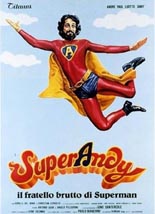 3. SuperAndy (SuperAndy, il fratello brutto di Superman)
3. SuperAndy (SuperAndy, il fratello brutto di Superman)
Superman’s “ugly brother,” as the Italian title states, is played by the bearded, beak-nosed Italian-American Andy Luotto, a voice actor who dubbed the English versions of Italian films in Rome and became a cult celebrity in Italy, thanks to the TV show L’altra domenica (which also featured a young Roberto Benigni), due to his lunar look and idiosyncratic behavior. Directed by the expert Paolo Bianchini, the movie is basically a spoof of Richard Donner’s Superman, with the newborn superhero being sent away from planet Trypton to Earth … and ending up in a middle-class Italian family. The film then concentrates on Andy as the unlikely superhero, by juxtaposing his superpowers with his clumsy persona and following his love story with a girl who does not recognize him when he is not wearing his costume (as people normally do with Clark Kent).
The result is an endearing, naive little film that even attempts a satiric discourse on capitalism: SuperAndy’s handsome brother, SuperKid, has become a TV personality and an advertising model in Hollywood, and is exploited like a slave by an evil agent (played by none other than Michele Mirabella, the unfortunate librarian of Lucio Fulci’s The Beyond). Ten years earlier, the transition from the small to the big screen would have been something rather common for an actor (see, for instance, the Diabolik spoof Arrriva Dorellik, starring singer Johnny Dorelli). However, by the end of the 1970s, it was a risky move. True, TV’s most popular shows drew in audiences of millions, but Italian cinema was rapidly falling in a comatose state. What is more, filmgoers had become much more demanding in their tastes. No wonder SuperAndy, il fratello brutto di Superman turned out to be a flop, despite Luotto’s popularity. The actor then gave it another try with Grunt! (1983), a parody of Jean-Jacques Annaud’s Quest for Fire he wrote, directed and starred, which turned out another flop.
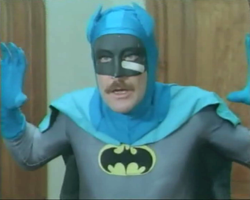 4. Bath-Man (Bath-man dal Pianeta Eros, 1982)
4. Bath-Man (Bath-man dal Pianeta Eros, 1982)
Here’s something that must be seen to be believed: a hardcore porn comedy featuring an alien mustached superhero (Manlio Cersosimo, Italy’s answer to Harry Reems) who wears a Batman cape, mask and costume (apparently director Antonio D’Agostino did not care about copyright) and has a female sidekick named Klito-Bell (aka Bath Baby). Their superpowers, needless to say, are of a sexual nature.
Bath-Man’s enemies are also liberally drawn from Bob Kane’s comics: The movie features a Catwoman whose raygun turns straight people into homosexuals, a Poker (sic!) who wears a jester’s costume and hat and has two Catwoman types nicknamed “Pussy-girls,” and a flamboyantly gay Penguin lookalike. Speaking of rip-offs, there are even “homages” to A Clockwork Orange and a music score that “borrows” from Serge Gainsbourg’s Je t’aime, moi non plus. Needless to say, it was shot on a shoestring: Instead of a Batmobile, the hero has to make do with a battered bycicle. How could the result be even remotely exciting to the raincoat crowd is anyone’s guess; however, Bath-man dal Pianeta Eros is so awfully bad, it demands a viewing from all fans of weird cinema.
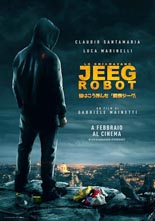 5. Enzo Ceccotti, Jeeg Robot (Lo chiamavano Jeeg Robot, 2015)
5. Enzo Ceccotti, Jeeg Robot (Lo chiamavano Jeeg Robot, 2015)
Gabriele Mainetti’s debut – a surprise word-of-mouth commercial and critical success in its home country, and the winner of seven “David di Donatello” awards, Italy’s equivalent to the Academy Awards – tells the story of an “accidental superhero” with a realistic approach (a bit like in Christopher Nolan’s Batman trilogy), but immersed within the problematic Italy of the new millennium, and does so with wit and irony.
The protagonist (played by Claudio Santamaria) is some sort of a modern-day Accattone (like the petty thief in Pier Paolo Pasolini’s film of the same name) who acquires superpowers after jumping into the putrid Tevere River to escape the cops. He lives in Rome’s disreputable Tor Bella Monaca district, full of pimps and drug dealers, and the first thing he does after learning about his super-strength is rob an ATM machine; only with time he will develop a social conscience, thanks to a slightly retarded girl who believes he is Jeeg Robot (the protagonist of Go Nagai’s manga and anime Steel Jeeg, immensely popular in 1970s Italy), and even knits him a wool mask to wear during his exploits. His antagonist (played by the talented Luca Marinelli, an astonishing cross between a young Tomas Milian and Night Train Murders’ Flavio Bucci) is an ex-talent show contender, who uploads his criminal deeds to YouTube and is after popularity rather than money.
Despite its title, Lo chiamavano Jeeg Robot is deeply Italian in the way it depicts the country’s malaise (the social angst among the lower classes, the widespread criminality in the suburbs, the younger generations’ superficiality and narcissism), and yet for its narrative and spectacular qualities, it can be savored abroad as well. On top of that, it is something that cannot be seen for the previous entries in this list: a truly remarkable movie, and an instant cult item that proves how Italian cinema still has vital blood in itself. —Roberto Curti
